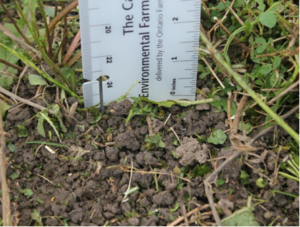Frost seeding or the broadcasting of forage seed on frozen ground in late-winter or early-spring can be an effective way of improving the forage quality and yield of thinning pastures. It allows for the establishment of forages at reduced cost in an undisturbed sod and also shortens the non-grazing period in the spring.
For frost seeding to be successful, there needs to be some bare soil exposed in the existing stand. This will improve seed-to-soil contact at seeding time and will reduce competition from the existing stand in early spring.
Site Selection
For seeds to germinate there needs to be good seed-to-soil contact. The best sites for frost seeding are thinning grass stands with some exposed soil. Seedling establishment will be more successful in sites which were overgrazed or clipped (to 2 inches or 5 cm) last fall (Figure 1). The open sod, will allow for better freezing and thawing action this spring. Frost seeding will be least successful in fields with thick sod.
Time of Seeding
For most of Ontario, the best time to frost seed is from mid-March to early-April, once the snow is all or nearly all melted. Ideally, the ground freezes and thaws at least 2 to 3 times after the seed is broadcasted. This freeze-thaw action helps to incorporate the seeds into the soil surface. Avoid frost seeding on top of snow where run-off from rapid snow melt will wash the seed away.
Equipment
While a grain drill is ideal for uniform seed placement and distribution, drills are not likely able to handle the frozen ground and snow conditions that occur when frost seeding is typically done. Frost seeding is most often done using a spinner–spreader on an all-terrain vehicle (ATV), snowmobile or tractor. In small areas or areas that are particularly rough, a hand-held broadcaster may be the preferred option.
Species Selection

Red clover is the easiest forage species to successfully frost seed (Figure 2). The seed is dense, which improves seed-soil contact. It also germinates at low temperatures and has high seedling vigour, allowing it to start growing early in the spring. However, it is short-lived, so frost seeding of red clover may have to be done every 2 – 3 years. Birdsfoot trefoil and white clover have been frost seeded with varying degrees of success. Birdsfoot trefoil is more difficult and slower to establish than red clover, but it has the advantage in pasture situations of being “non-bloating”. Once established, it will grow well under a wide range of growing conditions. It also has the ability to reseed itself, so it persists much longer than red clover.
Alfalfa is not well suited for frost seeding because auto-toxicity prevents new alfalfa seedlings to grow in the presence of a mature alfalfa plant,.
Grass species are much more difficult than legumes to frost seed successfully. Research at the University of Wisconsin by Dr. Dan Undersander demonstrated greater establishment success with orchardgrass and Italian (annual) ryegrass than with timothy or reed canarygrass. Smooth bromegrass was intermediate for successful frost seeding establishment, but it is more winter hardy and persists longer than orchardgrass or Italian ryegrass.
Frost Seeding Rates (lbs/acre1)
Red clover 3 – 7
White clover 2 – 3
Birdsfoot trefoil 3 – 6
Orchardgrass 3 – 4
Italian ryegrass 4 – 8
Bromegrass 6 – 12
1. 1 kg/ha = 0.88 lb/ac
• Use the higher seeding rates when significant bare ground is visible
• Use the lower seeding rates when using a seed mixture
Fertilizer
While phosphorus fertilizer benefits the establishment of new seedlings, fertilizing a field in a frost seeding situation has the disadvantage of encouraging growth of the existing plants. A better option is a late-summer application of phosphorus and potash to promote growth and winter persistence of the newly established legumes.
In the year of seeding, if an adequate stand is established (40% or more legume), avoid the application of nitrogen (N) fertilizer. Nitrogen fertilizer will increase the competition from grasses. In stands where there is a low level of legume, there will be a yield response from the grasses to additional N. If nitrogen is applied to increase production, it should be limited to less than 50 kg/ha (44 lbs/ac) of actual N during the first season.
Harvest Management
Once the new seedlings are established, regular grazing or harvest will reduce competition from existing grasses and allow light penetration into the canopy. In the year of establishment, avoid overgrazing by keeping at least 5 – 8 cm (2 – 3 inches) of top growth.
